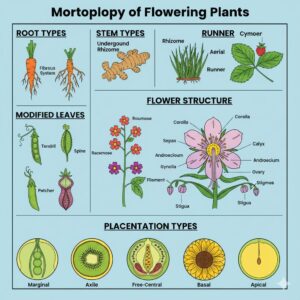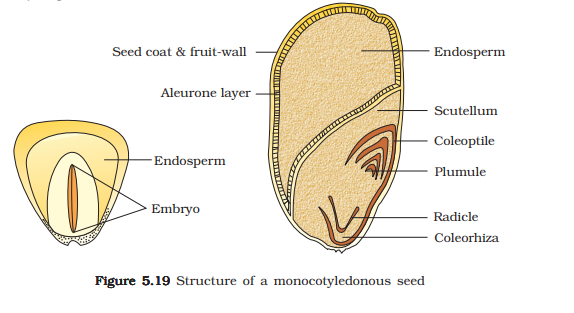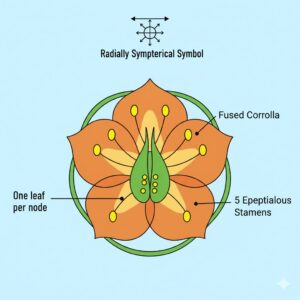1st PUC Biology Question and Answer: Morphology of Flowering Plants
Looking for 1st PUC Biology textbook answers? You can download Chapter 5: Morphology of Flowering Plants Questions and Answers PDF, Notes, and Summary here. 1st PUC Biology solutions follow the Karnataka State Board Syllabus, making it easier for students to revise and score higher in exams.
Karnataka 1st PUC Biology Textbook Answers—Reflections Chapter 5
Morphology of Flowering Plants Questions and Answers, Notes, and Summary
1st PUC Biology Chapter 5
Morphology of Flowering Plants
Scroll Down to Download Morphology of Flowering Plants Chapter 5
Answer the Following.
Question 1.
What is meant by modification of root? What type of modification of root is found in the: (a) Banyan tree (b) Turnip (c) Mangrove trees
Answer:
Modification of Root:
Modification of root refers to changes in the shape, structure, and function of roots from their normal form to perform special functions other than absorption of water and minerals. Roots can get modified for support, storage of food, or respiration.
Examples of Root Modifications:
Plant / Type | Type of Root Modification | Function |
(a) Banyan tree | Prop roots | Support – these roots grow from branches to the ground and help support the heavy branches. |
(b) Turnip | Tuberous root (swollen tap root) | Storage – stores food materials like carbohydrates. |
(c) Mangrove trees (e.g., Rhizophora) | Pneumatophores | Respiration – roots grow vertically upwards to obtain oxygen in swampy, waterlogged soil. |
So, root modifications are essentially adaptations of plants to their environment or specific functions.
Question 2.
Justify the following statements on the basis of external features:
(i) Underground parts of a plant are not always roots.
(ii) Flower is a modified shoot.
Answer:
- Underground parts of a plant are not always roots:
In some plants, stems remain underground to carry out additional functions like food storage and vegetative propagation.
Example: Potato is a modified underground stem (tuber). - A flower is a modified shoot:
When the stem takes on the role of reproduction, it is modified into a flower. The axis (thalamus) and leaf-derived parts (sepals, petals, stamens, carpels) indicate that a flower is structurally a modified shoot, not a root.
Question 3.
How is a pinnately compound leaf different from a palmately compound leaf?
Answer:
Feature | Pinnately Compound Leaf | Palmately Compound Leaf |
Definition | Leaflets are arranged along both sides of a central rachis (like a feather). | Leaflets arise from a common point at the tip of the petiole (like the fingers of a hand). |
Arrangement of leaflets | Along a central axis (rachis). | All leaflets emerge from one point. |
Examples | Rose, Neem, Ashoka | China rose, Palas, Cassia fistula |
Appearance | Resembles a feather. | Resembles a hand with spread fingers. |
Summary: Pinnate → leaflets along a central stalk; Palmate → leaflets radiate from a single point.
Question 4.
Explain with suitable examples the different types of phyllotaxy.
Answer:
- Pinnately compound leaf: The leaflets are arranged along a common central axis (rachis).
Example: Neem, Rose. - Palmately compound leaf: All the leaflets arise from a single common point at the tip of the petiole.
Example: Cotton, China rose.
Tip: Pinnate = feather-like, Palmate = hand-like.
Question 5.
Define the following terms:
- aestivation
- placentation
- zygomorphic
- superior ovary
- (c) actinomorphic
- perigynous flower
- epipetalous stamen
Answer:
(a) Aestivation:
- The arrangement of petals or sepals in a flower bud relative to each other before the flower opens.
- Example: China rose (holostemonous), Gulmohar.
(b) Placentation:
- The arrangement of ovules within the ovary of a flower.
- Example: Tomato (axile), Mustard (parietal).
(c) Actinomorphic:
- Flowers that are radially symmetrical; they can be divided into two equal halves along multiple planes.
- Example: Mustard, China rose.
(d) Zygomorphic:
- Flowers that are bilaterally symmetrical; they can be divided into two equal halves along only one plane.
- Example: Pea, Gulmohar.
(e) Superior ovary:
- Ovary that is attached above the point of attachment of other floral parts (sepals, petals, stamens).
- Example: Tomato, Mustard.
(f) Perigynous flower:
- Flower in which sepals, petals, and stamens are attached around the ovary, forming a cup-like structure called hypanthium. Ovary is half-inferior.
- Example: Plum, Rose.
(g) Epipetalous stamen:
- Stamens that are attached to the petals rather than the receptacle.
- Example: Brinjal, Tomato.
Question 6.
Differentiate between
- Racemose and cymose inflorescence
- Fibrous root and adventitious root
- Apocarpous and syncarpous ovary
Answer:
(a) Racemose and Cymose Inflorescence:
In racemose inflorescence, the main axis grows continuously (indefinite growth) and the oldest flowers are found at the base. Lateral flowers develop from the sides of the axis. Examples include mustard and cabbage. In cymose inflorescence, the main axis ends in a flower (definite growth) and the oldest flowers are at the top or center. Lateral flowers arise from the axils of bracts. Examples include calotropis and jasmine.
(b) Fibrous Root and Adventitious Root:
A fibrous root develops from the radicle and consists of many thin roots of nearly equal size. Its main function is anchoring and absorption. Examples include grass and wheat. An adventitious root arises from any plant part other than the radicle, such as stems or leaves. These roots may be thick, thin, or modified for support, climbing, or storage. Examples include prop roots of banyan and tuberous roots of sweet potato.
(c) Apocarpous and Syncarpous Ovary:
An apocarpous ovary has carpels that are free and not fused, with each carpel forming a separate ovary. Examples include ranunculus and rose. A syncarpous ovary has carpels fused together to form a single compound ovary. Examples include mustard and hibiscus.
Question 7.
Draw the labelled diagram of the following:
(i) gram seed
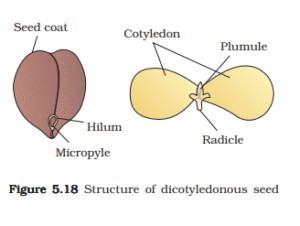
(ii) V.S. of maize seed
Question 8.
Describe modifications of stem with suitable examples.
Answer:
Modifications of Stem
Stems are modified to perform special functions such as food storage, climbing, protection, photosynthesis, and vegetative reproduction.
- Food Storage:
- Underground stems are modified to store food and help plants survive unfavorable conditions.
- Examples: Potato (tuber), Ginger and Turmeric (rhizomes), Zaminkand, Colocasia (corms).
- Tendrils:
- Stems may form slender, spirally coiled tendrils from axillary buds to help the plant climb.
- Examples: Cucumber, Pumpkin, Watermelon, Grapevine.
- Thorns:
- Axillary buds may develop into hard, pointed thorns for protection against herbivores.
- Examples: Citrus, Bougainvillea.
- In some arid plants, stems are modified into flattened (Opuntia) or fleshy cylindrical (Euphorbia) structures containing chlorophyll and performing photosynthesis.
- Vegetative Reproduction:
- Some stems help in asexual propagation by spreading to new niches.
- Examples:
- Grass and Strawberry – horizontal underground or above-ground stems.
- Mint and Jasmine – slender lateral branches arch down to touch the ground.
- Pistia and Eichhornia – lateral branches with short internodes, leaf rosettes, and roots.
- Banana and Pineapple – underground lateral branches grow horizontally and then obliquely upward, giving rise to new shoots.
Summary: Stem modifications enable plants to store food, climb, protect, photosynthesize, and reproduce vegetatively, helping them survive and spread efficiently.
Question 9.
Take one flower each of the families Fabaceae and Solanaceae and write its semi-technical description. Also draw their floral diagram after studying them.
Answer:
1. Family Fabaceae (Papilionaceae)
Example: Pea (Pisum sativum)
Vegetative Characters:
- Herbs, shrubs, or climbers; roots with root nodules.
- Stem: erect or climbing.
- Leaves: alternate, pinnately compound or simple, stipulate, reticulate venation.
Floral Characters:
- Inflorescence: racemose
- Flower: bisexual, zygomorphic
- Calyx: 5 sepals, gamosepalous, imbricate aestivation
- Corolla: 5 petals, polypetalous, papilionaceous (standard, wings, keel), vexillary aestivation
- Androecium: 10 stamens, diadelphous, anthers dithecous
- Gynoecium: superior ovary, monocarpellary, unilocular with many ovules, single style
- Fruit: legume; seeds 1–many, non-endospermic
Floral Formula:

Economic Importance: Pulses (gram, moong), edible oils (soybean, groundnut), dye (Indigofera), fibres (sunhemp), fodder (Sesbania), ornamentals (sweet pea), medicine (Muliathi).
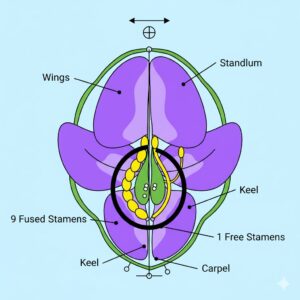
- Family Solanaceae (Potato Family)
Example: Tomato (Solanum lycopersicum)
Vegetative Characters:
- Mostly herbs, shrubs, or small trees; stem herbaceous, aerial, cylindrical, branched, may be hairy or glabrous.
- Leaves: alternate, simple, exstipulate, reticulate venation.
Floral Characters:
- Inflorescence: solitary, axillary, or cymose
- Flower: bisexual, actinomorphic
- Calyx: 5 sepals, gamosepalous, persistent, valvate aestivation
- Corolla: 5 petals, gamopetalous, valvate aestivation
- Androecium: 5 stamens, epipetalous
- Gynoecium: superior ovary, bicarpellary, syncarpous, bilocular, placenta swollen with many ovules
- Fruit: berry or capsule; seeds many, endospermous
Floral Formula:

Economic Importance: Food (tomato, brinjal, potato), spices (chilli), medicine (belladonna, ashwagandha), fumigatory (tobacco), ornamentals (petunia).
Floral Diagram: Draw a radially symmetrical flower showing fused corolla, 5 epipetalous stamens, and a bicarpellary ovary.
Question 10.
Describe the various types of placentations found in flowering plants.
Answer:
The arrangement of ovules within the ovary is known as placentation. There are several types of placentation:
- Marginal Placentation:
- The placenta forms a ridge along the ventral suture of the ovary.
- Ovules are borne on this ridge forming two rows.
- Example: Pea (Pisum sativum).
- Axile Placentation:
- The placenta is axial, and ovules are attached to it in a multilocular ovary.
- Example: China rose (Hibiscus), Tomato (Solanum lycopersicum), Lemon (Citrus).
- Parietal Placentation:
- Ovules develop on the inner wall or peripheral part of the ovary.
- Ovary is one-chambered, but may become two-chambered due to formation of a false septum.
- Example: Mustard (Brassica), Argemone.
- Free-central Placentation:
- Ovules are borne on a central axis, and septa are absent.
- Example: Dianthus, Primrose (Primula).
- Basal Placentation:
- Placenta develops at the base of the ovary, and a single ovule is attached.
- Example: Sunflower (Helianthus), Marigold (Tagetes).
Question 11.
What is a flower? Describe the parts of a typical angiosperm flower.
Answer:
Flower:
A flower is the reproductive unit in angiosperms and is meant for sexual reproduction. A typical flower has four different kinds of whorls arranged successively on the swollen end of the stalk or pedicel, called the thalamus or receptacle. These whorls are: Calyx, Corolla, Androecium, and Gynoecium.
- Calyx:
- Outermost whorl of the flower; members are called sepals.
- Usually green and leaf-like, protecting the flower in the bud stage.
- Sepals may be free (polysepalous) or united (gamosepalous).
- Corolla:
- Composed of petals, usually brightly colored to attract pollinators.
- Petals may be free or united.
- Shape and color vary widely: tubular, bell-shaped, funnel-shaped, wheel-shaped, etc.
- Androecium (Male Reproductive Part):
- Composed of stamens, each having:
- Filament:
- Anther: Usually bilobed, with two chambers (pollen sacs) producing pollen grains.
- Stamens may be:
- Epipetalous: Attached to petals (e.g., Brinjal)
- Ephyllous: Attached to perianth (e.g., Lily)
- Stamens may be united into bundles:
- Monadelphous: One bundle (e.g., China rose)
- Diadelphous: Two bundles (e.g., Pea)
- Polyadelphous: More than two bundles (e.g., Citrus)
- Gynoecium (Female Reproductive Part):
- Composed of one or more carpels, each having:
- Ovary: Enlarged basal part containing ovules attached to the placenta.
- Style: Elongated tube connecting ovary to stigma.
- Stigma: Receptive surface for pollen grains at the tip of the style.
Question 12.
How do the various leaf modifications help plants?
Answer:
Leaves in plants are modified in different ways to perform specific functions that help the plant survive in its environment. Some important leaf modifications and their functions are:
- Tendrils:
- Example: Pea, Grapevine.
- Function: Help the plant climb and support itself.
- Spines:
- Example: Cactus, Bougainvillea.
- Function: Protect the plant from herbivores and reduce water loss.
- Succulent leaves:
- Example: Aloe, Opuntia.
- Function: Store water in arid conditions.
- Phyllodes:
- Example: Acacia.
- Function: Flattened petioles perform photosynthesis instead of normal leaves.
- Insectivorous leaves:
- Example: Nepenthes, Drosera.
- Function: Trap and digest insects to obtain nutrients in nutrient-poor soils.
- Leaf tendrils from petioles or leaflets:
- Example: Passiflora.
- Function: Help in climbing or supporting weak stems.
- Storage leaves:
- Example: Onion, Garlic.
- Function: Store food and nutrients.
- Floating leaves:
- Example: Hydrilla, Nymphaea.
- Function: Help in photosynthesis and buoyancy in aquatic plants.
- Reproductive leaves:
- Example: Bryophyllum.
- Function: Produce new plants from leaf margins (vegetative propagation).
Question 13.
Define the term inflorescence. Explain the basis for the different types inflorescence in flowering plants.
Answer:
Inflorescence is the arrangement of flowers on the floral axis. The classification of inflorescence is based on whether the apex of the main axis continues to grow or terminates in a flower. If the apex continues to grow, producing flowers laterally in acropetal succession, it is called racemose (indeterminate) inflorescence. If the apex terminates in a flower, and further flowers develop from lateral branches, it is called cymose (determinate) inflorescence. This distinction forms the basis for the different types of inflorescence in flowering plants.
Question 14.
Write the floral formula of a actinomorphic, bisexual, hypogynous flower with five united sepals, five free petals, five free stamens and two united carples with superior ovary and axile placentation.
Answer:

Question 15.
Describe the arrangement of floral members in relation to their insertion on thalamus.
Answer:
The arrangement of floral members (sepals, petals, stamens, carpels) on the thalamus (receptacle) is called the floral insertion. Based on the position of the ovary in relation to the other floral parts, flowers are classified into three main types:
- Hypogynous Flower (Superior Ovary):
- The ovary is positioned above the point of attachment of sepals, petals, and stamens.
- Other floral parts arise below the ovary on the thalamus.
- Example: Mustard, China rose, Petunia.
- Perigynous Flower (Half-inferior Ovary / Cup-shaped Thalamus):
- The ovary is situated in a shallow cup-like thalamus.
- Sepals, petals, and stamens are attached to the rim of the cup surrounding the ovary.
- Ovary is half-superior or partly embedded.
- Example: Plum, Rose, Cherry.
- Epigynous Flower (Inferior Ovary):
- The ovary is positioned below the point of attachment of sepals, petals, and stamens.
- Other floral parts arise above the ovary, often appearing to grow from its top.
- Example: Cucumber, Guava, Sunflower.

